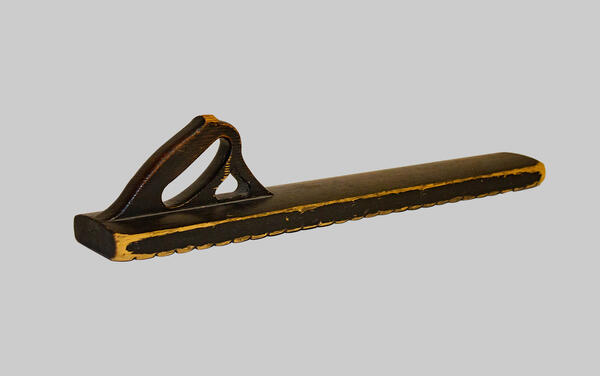A rubel is a small but rather heavy wooden narrow plate with strips cut across and a short rounded handle. Before the advent of the metal iron, rubels were used for ironing linen. To iron the linen, the washed and dried item was neatly wound on a special rolling pin, and then, putting a rubel on the roll, ‘rolled’ on a flat hard surface with the strongest pressure. The ribbed surface of the rubel kneaded the fabric, which was stiff after washing, and smoothed out the ‘wrinkles’.
However, the functions of the rubel were not limited to ironing the laundry. It often served as a musical instrument. For this, the handle was made hollow and dry grains of peas, millet, or rye were poured into it. The rubel itself was also made hollow so that when it was carried along its ribbed surface, it resonated. The musical rubel was usually shorter than the ironing one, with sharper ribs. The rubel was played with a wooden spoon or a small dry stick. The resulting sound was loud and dull. This characteristic ‘crackling’ sound is still in demand by orchestras of folk instruments and folklore groups. The musical rubel emphasizes the performance of various short arpeggios and grace notes.
It was preferred to make it from hard deciduous trees: oak, beech, and elm. The ends of the rubels were smoothly sawed and rounded off with a file. Sometimes additional rollers were cut on the ribbed surface. To do this, notches were made on each wave, sawed off, and then additionally rounded off with a chisel. The overhead handle appeared on the ruble later than the monolithic handle. On older rubels, the handle was cut directly on the board.
The rubel was often decorated with intricate designs or carvings and presented as a gift. The groom could give a rubel to his beautiful bride, having carved out the woman’s initials in addition to the pattern. With this gift, the groom at the same time checked the future wife for “suitability”. In different regions, rubels could differ in size, shape, ornament, and painted pattern. Sometimes a rubel was shaped like a female body: the top was narrower, gradually expanding downward.
However, the functions of the rubel were not limited to ironing the laundry. It often served as a musical instrument. For this, the handle was made hollow and dry grains of peas, millet, or rye were poured into it. The rubel itself was also made hollow so that when it was carried along its ribbed surface, it resonated. The musical rubel was usually shorter than the ironing one, with sharper ribs. The rubel was played with a wooden spoon or a small dry stick. The resulting sound was loud and dull. This characteristic ‘crackling’ sound is still in demand by orchestras of folk instruments and folklore groups. The musical rubel emphasizes the performance of various short arpeggios and grace notes.
It was preferred to make it from hard deciduous trees: oak, beech, and elm. The ends of the rubels were smoothly sawed and rounded off with a file. Sometimes additional rollers were cut on the ribbed surface. To do this, notches were made on each wave, sawed off, and then additionally rounded off with a chisel. The overhead handle appeared on the ruble later than the monolithic handle. On older rubels, the handle was cut directly on the board.
The rubel was often decorated with intricate designs or carvings and presented as a gift. The groom could give a rubel to his beautiful bride, having carved out the woman’s initials in addition to the pattern. With this gift, the groom at the same time checked the future wife for “suitability”. In different regions, rubels could differ in size, shape, ornament, and painted pattern. Sometimes a rubel was shaped like a female body: the top was narrower, gradually expanding downward.



